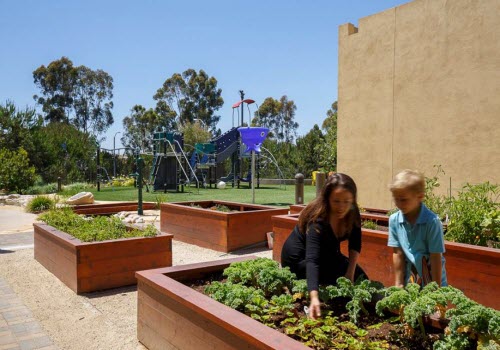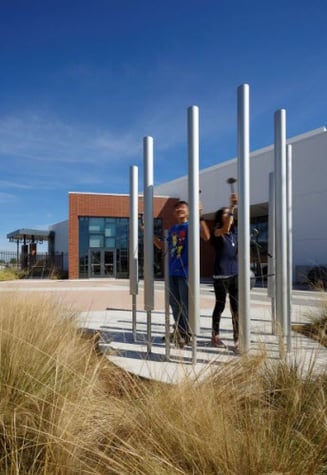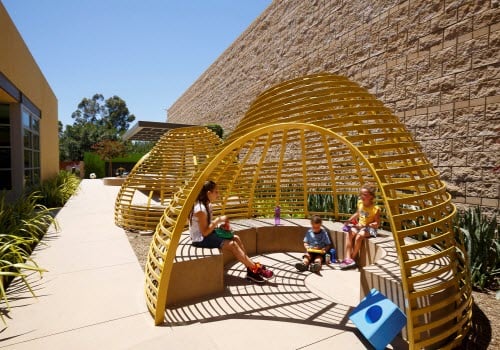Seeing Drought as Opportunity in Educational Spaces
 The recent el Nino storms may seem to be quelling California’s drought, but the reality is we’re not out of the woods yet. California is the most populous state, home to 38.7 million people as of January 2015. Since about half of municipal water use is devoted to landscaping, there are significant opportunities for conservation.
The recent el Nino storms may seem to be quelling California’s drought, but the reality is we’re not out of the woods yet. California is the most populous state, home to 38.7 million people as of January 2015. Since about half of municipal water use is devoted to landscaping, there are significant opportunities for conservation.
The current drought has caused legislators to address concerns about ongoing water scarcity in multiple ways. The focus of one such regulation limits how much water can be used in the landscape. The new code, which basically compels school districts to include landscape rehabilitation in building expansion or new construction projects over a certain size, are aimed at creating an aggregate reduction of water used for irrigation purposes. The good news is that could turn out to be the one of the best things to happen to educational facilities (and students) in a long time.
 These regulations create an opportunity for schools to enhance their campus and enrich the curriculum by adding valuable landscape design elements. Schools all over the state have a surplus of ornamental lawns that are currently under-utilized or not functional at all. Turf, which needs a lot of irrigation water to survive in most of California, should be thought of as a lavish expense of water for a specific purpose. Sports fields, flexible courtyard space, or amphitheater lawns are all specific purposes, but often these types of spaces are only a small percentage of a school’s turf. The ornamental lawns—the front lawns, the spaces between buildings, and the small patches of turf not used for a specific function—are the low-hanging fruit when it comes to landscape irrigation.
These regulations create an opportunity for schools to enhance their campus and enrich the curriculum by adding valuable landscape design elements. Schools all over the state have a surplus of ornamental lawns that are currently under-utilized or not functional at all. Turf, which needs a lot of irrigation water to survive in most of California, should be thought of as a lavish expense of water for a specific purpose. Sports fields, flexible courtyard space, or amphitheater lawns are all specific purposes, but often these types of spaces are only a small percentage of a school’s turf. The ornamental lawns—the front lawns, the spaces between buildings, and the small patches of turf not used for a specific function—are the low-hanging fruit when it comes to landscape irrigation.
There is huge potential for these spaces to be rehabilitated into low-water outdoor learning spaces that enrich the learning opportunities of students and provide a sustainable landscape design. They can be converted into outdoor classrooms used to teach about horticulture, biology, geology and other earth sciences. They can become kitchen gardens, planted and cared for by the students, which strengthen the child’s food literacy and nutrition education, as well as become source of pride and nourishment. They can become stormwater management gardens, which function as a laboratory for students to see how plants and soil filter stormwater run-off. They can become social learning spaces as well, with breakout pods for study groups and quiet reflection. They can become flexible space used as an extension of the classroom in the morning, a dining area at lunch, and then a makerspace in the afternoon. When land is so expensive and difficult to come by, these under-utilized spaces can become a way for schools to reduce their water needs and add valuable square footage of learning space.
 We believe that learning happens everywhere, and there is a growing body of evidence which shows a connection with nature enhances the learning experience for students. As this world becomes increasingly digitalized and urbanized, many students have little or no access to a safe outdoor space to play and explore. Schools, oftentimes, are their only place to interact with the outdoors. It’s imperative to our future that children grow up with a positive experience of the natural world. After all, we rely on the earth for all our food, air and resources.
We believe that learning happens everywhere, and there is a growing body of evidence which shows a connection with nature enhances the learning experience for students. As this world becomes increasingly digitalized and urbanized, many students have little or no access to a safe outdoor space to play and explore. Schools, oftentimes, are their only place to interact with the outdoors. It’s imperative to our future that children grow up with a positive experience of the natural world. After all, we rely on the earth for all our food, air and resources.
Natural environments have been shown to stimulate creativity and social interaction (think of kids playing on a playground) and reduce social conflicts like bullying, vandalism and littering. The color of the sky, even, has been shown to produce twice as many creative outputs as the color red. A recent study in Illinois found that spending as little as fifteen minutes in a park reduced students’ stress and rehabilitated the mind faster, allowing students to come back to class more focused and more capable of learning. That same study found that views of trees from the classroom can even have a similar restorative effect. Creating enriching outdoor space by replacing ornamental lawns with climate-appropriate trees and shrubs is one way schools can realize the benefits of the natural environment. What’s more, these restorative and relaxing properties aren’t just limited to students—teachers and faculty can reap the rewards as well.
As schools and districts are looking for ways to save water, I would urge them to take a second look at how the turf grass on their campus is being used and think if that space could be better used for something more beneficial. These under-utilized spaces can easily be converted to save water, reduce stress, build value and energize a school. The variety and function of an outdoor space is only limited by the imagination, and, as it turns out, the outdoors is good for the imagination.
Andrew Wickham, ASLA is a Landscape Designer at LPA Inc. He is a LEED accredited professional who specializes in K-12 School design.
